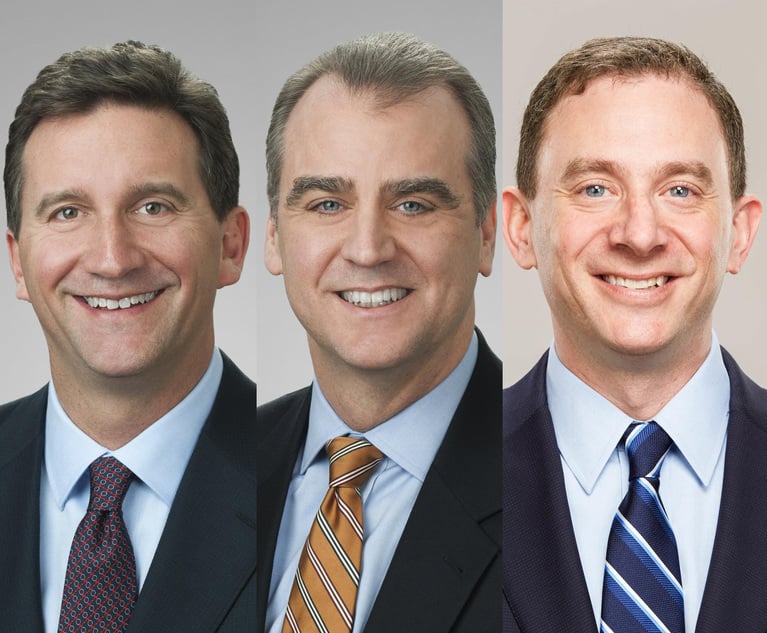Litigators of the Week: Big Law Trio Deflate Suits Against Viagra and Cialis
'The suggestion that these medicines might be linked to melanoma in patients was something our clients felt very strongly was not true.'
January 17, 2020 at 02:53 AM
7 minute read
 L-R: Loren H. Brown of DLA Piper, Michael X. Imbroscio of Covington & Burling and Joseph G. Petrosinelli of Williams & Connolly.
L-R: Loren H. Brown of DLA Piper, Michael X. Imbroscio of Covington & Burling and Joseph G. Petrosinelli of Williams & Connolly.
The Litigator of the Week award goes to a trio of lawyers: Loren Brown at DLA Piper; Michael Imbroscio at Covington & Burling and Joseph Petrosinelli at Williams & Connolly.
They teamed up on behalf of Eli Lilly & Co. and Pfizer, which faced about 1,200 suits from men who claimed that taking Viagra or Cialis caused them to develop the deadly skin cancer melanoma.
The three lawyers joined forces to score a home run Daubert ruling in the Northern District of California that guts the plaintiffs' case. U.S. District Judge Richard Seeborg on Jan. 13 rejected the plaintiffs' expert testimony, ruling that "there simply is no interpretation by anyone other than plaintiffs experts that supports general causation."
Petrosinelli, Imbroscio and Brown discussed the case with Lit Daily.
Lit Daily: Who are your clients and what was at stake?
Joe Petrosinelli: We represent Pfizer and Lilly, the manufacturers of Viagra and Cialis, respectively. These medicines have been used by tens of millions of men around the world for 20 years.
The suggestion that these medicines might be linked to melanoma in patients was something our clients felt very strongly was not true based on the science, and they were committed to defending these beneficial products. Ultimately substantial numbers of individual lawsuits making this claim were filed in the MDL.
Tell us about the 2014 study and the allegations against your clients.
Loren Brown: The trigger for this litigation was a small epidemiological study published in a medical journal in 2014. Based on just a handful of events, the study reported a statistical 84% increased risk in melanoma among Viagra users.
From our perspective, and as we learned later from other scientists' perspectives, the study had a variety of serious methodological flaws that called into question its results, as even the authors of the study cautioned at the time.
Those cautions, however, did not stop a rush of advertising and flurry of lawsuits. These lawsuits were eventually centralized in an MDL before Judge Richard Seeborg in San Francisco, and Ernie Cory of Cory Watson was appointed lead counsel for plaintiffs. Joe and I were co-leads for Pfizer, and Mike was lead for Lilly.
When and how did each of you come to be involved in the case?
Joe Petrosinelli: Loren and I have partnered together on several prior product liability matters for Pfizer and other clients, so when Pfizer saw its first Viagra lawsuit in 2015 shortly after the publication of the initial study, it was a natural fit.
When Lilly got brought into the litigation with Cialis in 2016, we welcomed Mike with open arms, and it has been terrific to collaborate with him and his colleagues in defending these cases.
Had you worked together or known each before this case? How did you divide up responsibilities?
Mike Imbroscio: Although Joe and Loren are leaders in the field and have worked together for other clients in the past, this was actually the first time I had worked with either. It has been a great experience.
While we each had our teams focusing on client-specific facts and expert development, we needed to coordinate strategy remarkably closely. When it came time to draft the joint Daubert motion, I can truly say I've never seen in my 25-year career a more collaborative effort for such a major filing.
What challenges did you face in working across three firms? Did it also confer some advantages?
Joe Petrosinelli: You'll think I'm not being straight, but we really had no bumps at all as the litigation progressed. Up and down the chain, our teams worked seamlessly together, and while we had to make some tough strategy calls along the way, there was not a single issue where we did not reach consensus almost immediately.
This case has been all about the experts. Tell us about yours.
Loren Brown: We were lucky to have been able to retain some of the world's leaders in melanoma research across two continents, including one expert who was the senior author of a preclinical study that the plaintiffs' experts relied heavily on.
That expert actually testified that the reason he was willing to get involved in American litigation was because he was bothered by how the plaintiffs' experts, in his view, were misstating the results of his laboratory's research.
What strategies did you use to rebut the plaintiffs experts?
Mike Imbroscio: We were facing very good lawyers on the other side, and unlike in some litigations we face, the experts for the plaintiffs certainly had impressive qualifications.
In the end, we were able to demonstrate that what those experts were trying to do here—support a causation opinion based on the existing science—was something that literally no one else in the world outside of our courtroom was willing to do. Such a lack of any acceptance in the outside scientific and regulatory communities is a classic indicator of a lack of reliability, as the court found.
Judge Seeborg wrote that "defendants' theme that 'science has worked the way it is supposed to' is compelling." What did he mean by that?
Loren Brown: After the original study came out in 2014 and received national publicity, scientists in the field embarked upon an intensive study of the issue. None of those studies concluded that the evidence supported a causal connection between Viagra or Cialis and melanoma, and many found persuasive evidence to the contrary.
As a result, the scientific community moved on, but here we were with all of these lawsuits. As the court recognized, that scientific journey, by experts outside the context of litigation, was a key indicator that plaintiffs' experts' opinions did not satisfy Daubert.
What stands out as a high point during the four-day hearing?
Mike Imbroscio: We had to present or cross-examine seven different expert witnesses over a tight three-day period, with closings on the fourth day. We took that challenge as an opportunity to showcase the talents of our broader team.
While Joe, Loren, and I each took a witness and Joe opened and closed, Emily Ullman and Kathleen Paley at Covington, Matt Holian at DLA, and Lori Leskin at Arnold & Porter all were able to handle witnesses at the hearing, and this diversity of styles and talents really shined through.
What happens next? How is this decision likely to affect the underlying litigation?
Joe Petrosinelli: The court has asked the parties to confer on that very question, but we believe that with plaintiffs now lacking admissible expert testimony on general causation, the cases cannot proceed.
This content has been archived. It is available through our partners, LexisNexis® and Bloomberg Law.
To view this content, please continue to their sites.
Not a Lexis Subscriber?
Subscribe Now
Not a Bloomberg Law Subscriber?
Subscribe Now
NOT FOR REPRINT
© 2025 ALM Global, LLC, All Rights Reserved. Request academic re-use from www.copyright.com. All other uses, submit a request to [email protected]. For more information visit Asset & Logo Licensing.
You Might Like
View All
Litigators of the (Past) Week: Defending Against a $290M Claim and Scoring a $116M Win in Drug Patent Fight

Litigators of the Week: A Trade Secret Win at the ITC for Viking Over Promising Potential Liver Drug

Litigation Leaders: Mark Jones of Nelson Mullins on Helping Clients Assemble ‘Dream Teams’

Litigators of the Week: An Early Knockout Win in the Decongestant MDL
Law Firms Mentioned
Trending Stories
Who Got The Work
J. Brugh Lower of Gibbons has entered an appearance for industrial equipment supplier Devco Corporation in a pending trademark infringement lawsuit. The suit, accusing the defendant of selling knock-off Graco products, was filed Dec. 18 in New Jersey District Court by Rivkin Radler on behalf of Graco Inc. and Graco Minnesota. The case, assigned to U.S. District Judge Zahid N. Quraishi, is 3:24-cv-11294, Graco Inc. et al v. Devco Corporation.
Who Got The Work
Rebecca Maller-Stein and Kent A. Yalowitz of Arnold & Porter Kaye Scholer have entered their appearances for Hanaco Venture Capital and its executives, Lior Prosor and David Frankel, in a pending securities lawsuit. The action, filed on Dec. 24 in New York Southern District Court by Zell, Aron & Co. on behalf of Goldeneye Advisors, accuses the defendants of negligently and fraudulently managing the plaintiff's $1 million investment. The case, assigned to U.S. District Judge Vernon S. Broderick, is 1:24-cv-09918, Goldeneye Advisors, LLC v. Hanaco Venture Capital, Ltd. et al.
Who Got The Work
Attorneys from A&O Shearman has stepped in as defense counsel for Toronto-Dominion Bank and other defendants in a pending securities class action. The suit, filed Dec. 11 in New York Southern District Court by Bleichmar Fonti & Auld, accuses the defendants of concealing the bank's 'pervasive' deficiencies in regards to its compliance with the Bank Secrecy Act and the quality of its anti-money laundering controls. The case, assigned to U.S. District Judge Arun Subramanian, is 1:24-cv-09445, Gonzalez v. The Toronto-Dominion Bank et al.
Who Got The Work
Crown Castle International, a Pennsylvania company providing shared communications infrastructure, has turned to Luke D. Wolf of Gordon Rees Scully Mansukhani to fend off a pending breach-of-contract lawsuit. The court action, filed Nov. 25 in Michigan Eastern District Court by Hooper Hathaway PC on behalf of The Town Residences LLC, accuses Crown Castle of failing to transfer approximately $30,000 in utility payments from T-Mobile in breach of a roof-top lease and assignment agreement. The case, assigned to U.S. District Judge Susan K. Declercq, is 2:24-cv-13131, The Town Residences LLC v. T-Mobile US, Inc. et al.
Who Got The Work
Wilfred P. Coronato and Daniel M. Schwartz of McCarter & English have stepped in as defense counsel to Electrolux Home Products Inc. in a pending product liability lawsuit. The court action, filed Nov. 26 in New York Eastern District Court by Poulos Lopiccolo PC and Nagel Rice LLP on behalf of David Stern, alleges that the defendant's refrigerators’ drawers and shelving repeatedly break and fall apart within months after purchase. The case, assigned to U.S. District Judge Joan M. Azrack, is 2:24-cv-08204, Stern v. Electrolux Home Products, Inc.
Featured Firms
Law Offices of Gary Martin Hays & Associates, P.C.
(470) 294-1674
Law Offices of Mark E. Salomone
(857) 444-6468
Smith & Hassler
(713) 739-1250






